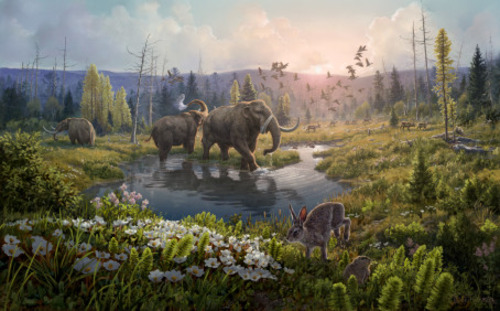
For the first time, two million-year-old DNA has been identified, opening a completely new and previously unexplored chapter in the history of evolution.
The researchers have found microscopic fragments of environmental DNA in sediments in northern Greenland. The research is now presented in the journal Nature.
Using advanced techniques, the researchers discovered that the fragments are a million years older than the previous record, which was a DNA sample taken from bone remains of a Siberian mammoth.
The prehistoric DNA has now been used to map a two-million-year-old ecosystem that existed during a time of extreme climate change.
– DNA can deteriorate quickly, but we have shown that under the right circumstances we can now go further back in time than anyone could have dared to imagine. Now a new chapter of prehistoric times is opening, a chapter that stretches back another million years and for the first time we can look directly at the DNA of a two million year old ecosystem, says Eske Willerslev, Fellow at St John’s College , University of Cambridge, and director of the Lundbeck Foundation GeoGenetics Centre.
Willerslev led the research group behind the new study together with Kurt H. Kjær, professor of geology at the Lundbeck Foundation GeoGenetics Centre.
– The old DNA samples were found deeply buried in sediments built up over a 20,000-year period. The sediment was preserved in ice or permafrost and has been unaffected by humans for two million years, which has been absolutely crucial, says Kurt H. Kjær.
The samples, only a few millionths of a millimeter long, were taken from the Cape København Formation. The formation consists of about 100 meters thick sediment deposits embedded in the mouth of a fjord in the Arctic Ocean at the northernmost point of Greenland. Two million years ago, the climate in Greenland varied between arctic and temperate. Although the era is called the Ice Age, the temperature in Greenland was then between 10–17°C warmer than today, and during one of the temperate periods the sediment was built up meter by meter in a shallow bay.
The researchers discovered DNA that proves the existence of animals, plants and microorganisms including reindeer, hares, lemmings, birches and poplar trees. They were even able to see that mastodons, an Ice Age mammal, roamed Greenland before the species later became extinct. Previously, it was not believed that the elephant-like animals existed in Greenland, so far away from its known origin in North and Central America.
The process of unlocking the secrets of the DNA fragments was time-consuming. First, the researchers managed to establish that there was actually DNA hidden in the sediments, then they had to extract it for examination. 41 of the samples were found to be useful. The researchers then compared each individual fragment to an extensive library of DNA collected from modern-day animals, plants and microorganisms. A picture began to emerge showing DNA from prehistoric trees, shrubs, birds, animals and microorganisms.
RELATED ARTICLES
- After Fooling the People to Reelect Putin, Russia now announces More Cannon Fodder Mobilizations
- Russia Fires Barrage of North Korean Missiles at Kyiv After US Visit
- Ex-Wagner fighters Join Free Russia Army's Battle to Liberate Russia from Putin Occupation
- Hungary Becomes First EU Country to Congratulate Putin for Winning the 'Elections'
- Researchers Warn Vaping is just as Harmful as Cigarettes











